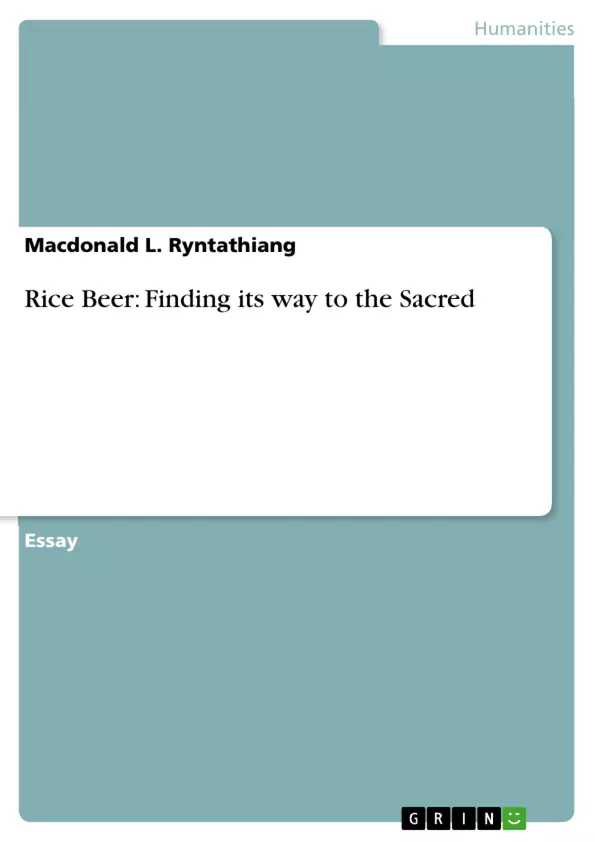Rice beer is used in different occasions. The main purpose of it is to represent as a symbolic tool for initiation and conclusion of certain rituals and ceremonies. In festivals and dances, without rice beer, the performers or dancers cannot enthusiastically display their performance, with charm and gaiety. Rice beer makes each and every individual participating in the dance to perform freely without hesitation and also refreshes them when they are weary and tired, especially during sunny day. One of the main reasons for it to become so important an entity in particular festivals or dance is that it is easily available and culturally associated with the life of the people. Rice beer maybe regarded as a tool of pleasure for relief to the people during festivities, but when it comes to performing rituals and uses for religious purposes, it becomes the most sacred item as a symbolic representation for reverence to the Gods and Goddesses.
The paper will try to understand the role of rice beer in the rituals and festivals, which we will look briefly at the 'Pynhir meidhan' ritual of the Bhoi in reverence to the Goddess Lukhmi and 'Ka krud Ksing' , a dance performed in Umtyrkhang, Mawhati also in Ri-Bhoi.
Inhaltsverzeichnis (Table of Contents)
- Introduction
- Rice Beer in Khasi Culture
- Uses in Rituals and Ceremonies
- Types of Rice Beer
- The Pynhir Meidhan Ritual
- The Role of Rice Beer in the Ritual
- Connections to Ancestor Worship
- Similarities with Vietnamese Rituals
- Ka Krud Ksing: Ploughing with Drums
- Rice Beer's Role in the Dance
- Community and Cultural Significance
- Conclusion (Not Included in Preview)
Zielsetzung und Themenschwerpunkte (Objectives and Key Themes)
This paper aims to explore the multifaceted role of rice beer in the cultural and religious practices of the Khasis in Meghalaya, India. The study focuses on how rice beer transcends its function as a simple beverage, instead serving as a powerful symbol within various rituals and ceremonies.
- The cultural significance of rice beer among the Khasis.
- The symbolic use of rice beer in rituals and ceremonies, particularly related to agriculture and ancestor worship.
- The connection between rice beer and fertility rites.
- Comparisons of Khasi rice beer rituals with similar practices in other cultures (e.g., Vietnam).
- The potential impact of modernization on traditional rice beer production and consumption.
Zusammenfassung der Kapitel (Chapter Summaries)
The introduction sets the stage by highlighting the importance of rice in Khasi culture and introduces rice beer as a key element in various aspects of life. The following section delves into the diverse uses of rice beer in rituals and ceremonies, emphasizing its symbolic role in marking the beginning and end of important events. Different types of rice beer are mentioned, highlighting their varying degrees of complexity in preparation. A detailed account of the Pynhir Meidhan ritual is then provided, explaining its purpose, participants, and the crucial role of rice beer in propitiating the rice goddess, Ka Lukhmi. The ritual's connection to ancestor worship and similarities to Vietnamese ceremonies are explored. Finally, the Ka Krud Ksing ritual, a community activity combining agricultural labor with a celebratory atmosphere, is examined, emphasizing again the significant role rice beer plays in sustaining energy and cultural heritage.
Schlüsselwörter (Keywords)
Rice beer, Khasi culture, Meghalaya, rituals, ceremonies, ancestor worship, fertility rites, Pynhir Meidhan, Ka Krud Ksing, Ka Lukhmi, cultural heritage, traditional practices, modernization.
- Citation du texte
- Macdonald L. Ryntathiang (Auteur), 2012, Rice Beer: Finding its way to the Sacred, Munich, GRIN Verlag, https://www.grin.com/document/186940



